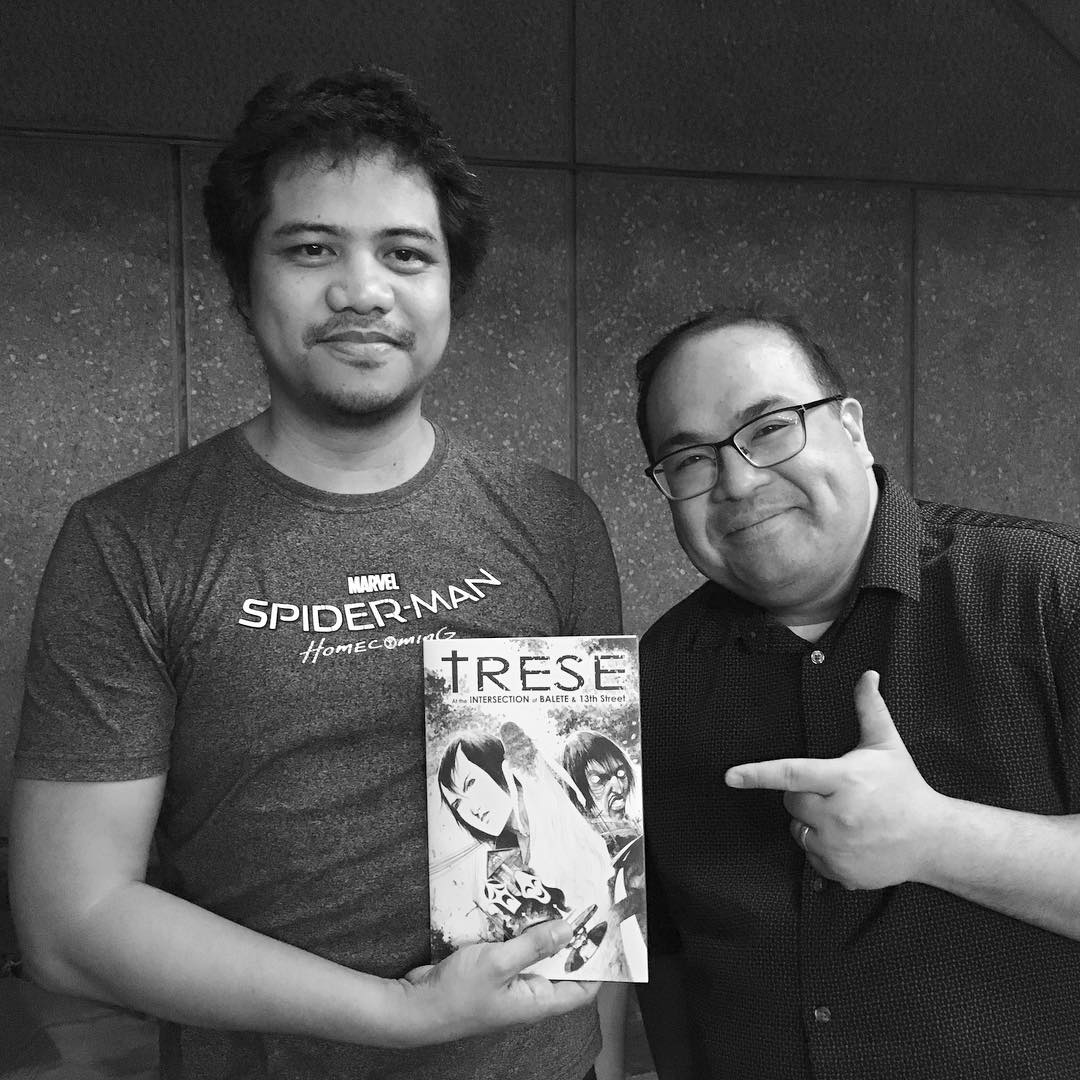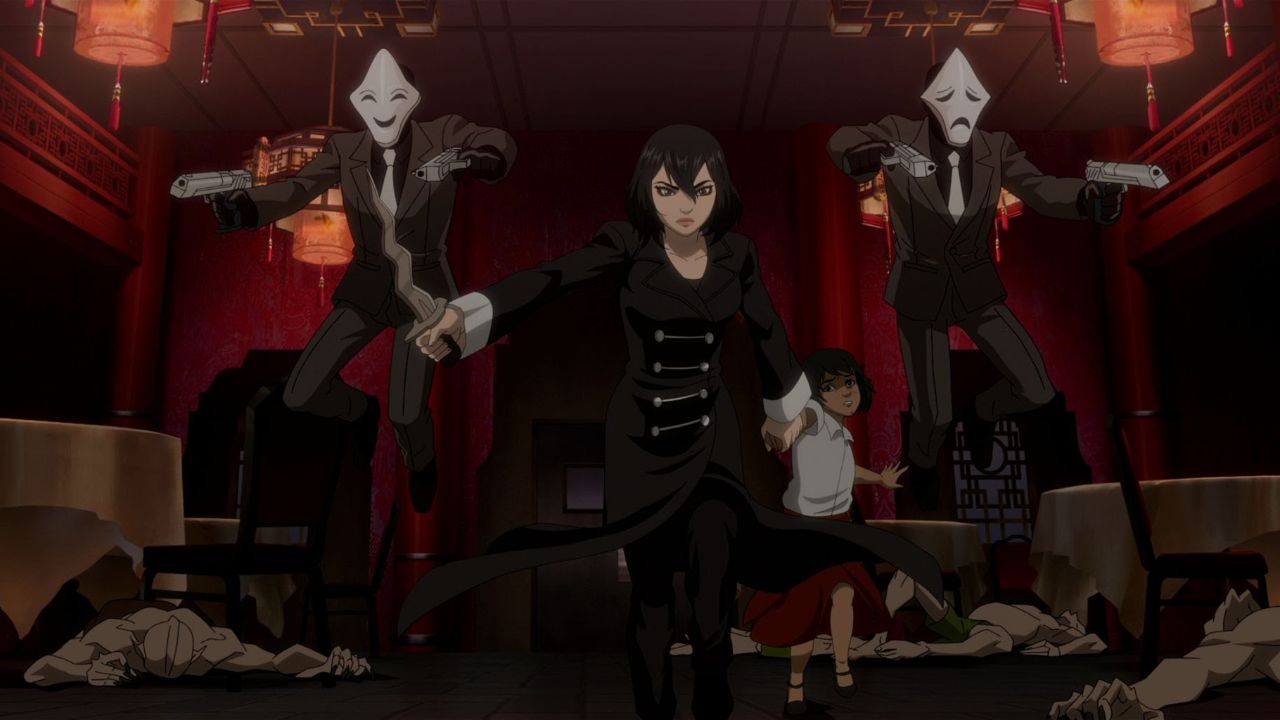‘Tabi-Tabi Po’
Writer Budjette Tan looks back at the beginnings of comic book-turned-anime “Trese.” With a big Netflix premiere, his kickass paranormal investigator aims to conquer the world — supernatural or otherwise.
By JESSICA BARTOLOME
June 10, 2021
“Tabi-tabi po.”
This is a common phrase of courtesy so deeply embedded in the Filipino culture that it’s muttered automatically, without much thought. Whether or not you believe in duwende or tikbalang or manananggal, it’s something you’re compelled to say when you’re walking through a mound of soil or a patch of wild grass.
Which is why it’s so startling to hear Alexandra Trese utter it in “Trese” — suddenly, a string of words so easily overlooked sounded special. Suddenly, a sentence you’d been hearing since you were a kid was being heard by strangers around the world.
“Where have I heard these words before?” co-creator Budjette Tan said wondrously as he recalled watching the first episode of the anime show. “It was like I’m having deja vu.”
The words, of course, came straight out of his comic book series co-created with Kajo Baldisimo. Before being adapted into anime by Netflix, “Trese” was already an award-winning piece of literature that had won the hearts of many Filipinos.
But before that, it was just a self-published comic that was photocopied and stapled together and sold at Comic Quest. Wanting to simply do it for fun, he and Kajo made only 30 copies in the beginning.
“It's unbelievable that our little photocopied comic book sold for P30 back in 2005 is now going to be the first Pinoy Netflix animated series,” Budjette told GMA News Online. “It's something I could not have guessed happening back in 2005.”
That year, Budjette had dug up an old script that he had been revisiting on and off since 2002 after Kajo asked him if he had a story he could draw.
“I kept going back to that story and I could never figure out how to end it,” Budjette recalled. “But when Kajo said, ‘Do you have a script? Can you make it 20 pages?’ It took me I think roughly a week or two weeks to go back to that story, rewrite it and lock it down to 20 pages, change the character into a woman, added the kambal, and that became the first issue.”

Alexandra Trese is a guardian of a magical Manila in the anime series. Screen capture: Netflix
You read that right — Alexandra Trese was originally a man.
“The first draft of Trese is he was actually a guy,” Budjette said. “He was a tough guy. So he was Anton Trese.”
The initial sketch handed over by Kajo was impressive and was exactly how Budjette had imagined Anton Trese. And yet, he had the nagging thought: “Why have I seen this before?”
“Oh, it’s another tough guy,” he eventually realized. “It’s another action star wearing a jacket. It’s another FPJ, Robin Padilla, Bong Revilla tough guy.”
Budjette then had a stroke of genius: what if Trese were a woman?
He said that at the time, it only took seconds for him to text the suggestion to Kajo. There wasn't much of a thought process behind it.
But looking back, Budjette said that he was probably influenced by the anime “Ghost in the Shell,” which he and Kajo were both watching independently at the time. He had also been reading the comic books “Global Frequencies” and “Jenny Sparks: The Secret History of the Authority.”
“I was reading and watching a lot of stuff where there was a strong female character, but they were not Pinoy,” he said. “Thinking about it, I think that was also part of the ingredients that made me flip the whole idea. And it just made me think that as far as Pinoy movies and Pinoy comics are concerned, we don’t have that tough badass female character saving the day.”
The idea was well received by Kajo, who agreed that Trese would be cooler as a woman. On the same day, the artist had a sketch of Trese with her devil’s haircut and deadly knife.
“I thought, ‘Yeah, this is it. She's our character,’” Budjette said.

Trese creators Kajo Baldisimo and Budjette Tan. Instagram: Budjette Tan
Alexandra Trese is a paranormal investigator who steps in whenever authorities encounter cases involving creatures straight out of Philippine folklore. She is the Babaylan-Mandirigma of Manila, a guardian of the city, overseeing both worlds.
Ever since her conception, Budjette said he’s kept her “very consistent.”
“She takes her job and her duty seriously and that’s the only thing that’s important for her, to fulfill that duty,” he said.
Fans, however, would get to see her in a new light in the anime adaptation, Budjette said. Apparently, he and Kajo didn’t actually have much to do with the production of the show.
“Me and Kajo would not have been able to devote as much time being part of the process. I’m far away and he has his job as well.”
Budjette wasn’t too worried — he had full trust in his friends and producers, Tanya Yuson and Shanty Harmayn.
For one, the pair had been pitching “Trese” to production companies for 10 years.
“There were moments when [Tanya] would say, ‘Oh there’s this group that’s interested,’ but there’s always a ‘but.’ And I was always like ‘Go for it, let’s do it now,’ but Tanya said ‘No, we’re going to wait,’” Budjette said.
In the beginning, Tanya and Shanty had aimed to have “Trese” adapted into a live action movie. There was always a tradeoff, though, so plans always fell through.
Fresh off another rejection from a studio in 2018, they learned that Netflix was looking for stories from other countries because its anime division just started.
It was as if a lightbulb went off.
“It just made perfect sense that it would be an anime,” Budjette said. “It would be the perfect medium to make all of these creatures and worlds come to life and you’re not worried about, ‘Is it going to look fake or not?’”
We know how it ends: obviously, Netflix liked the pitch. But what really sealed the deal for Budjette was, “Netflix basically said ‘Do whatever you want.’”
“It was... being given the right amount of creative freedom, being given the right amount to produce it,” he said. “[It was] Netflix saying make this as Filipino as possible.”

'Trese' producers got a directive from Netflix to make the anime as Filipino as possible. Screen capture: Netflix
Aside from featuring Filipino characters in a story set in Manila, “Trese” stayed in theme by hiring Filipino cast and crew. Even the soundtrack was sung by Filipino band UDD. The series launched in several languages, one of which is Tagalog.
But what Budjette was really thrilled about was how the incantations stayed the same.
“I’ve read the scripts, stuff got edited out, but yes, I got to watch it and I was just smiling like an idiot, especially when they used the exact words from the comic book,” he gushed.
“They kept ‘tabi-tabi po’,” he added, amazed. “It was a great decision by [showrunner] Jay Oliva and by Tanya to keep...certain Pinoy phrases, especially the magic words.”
There’s a perfect Tagalog word to describe what Budjette felt when he watched it for the first time: kilig.

'Trese' has fans from all over the world, with displays in book fairs such as in Frankfurt. Instagram: Budjette Tan
Budjette is now based in Denmark, but he grew up in Manila. And growing up in Manila, he couldn’t help but feel as if it was such a dangerous city.
Manileños might automatically agree, but Budjette made this statement after viewing reality through a unique lens.
“I grew up in the same environment where people were told you need to say ‘Tabi-tabi po.’ If you see a mount of dirt near a tree [there might be a] duwende. You need to hang garlic on your window [there might be] aswang [outside]. My mom told me stories about how we used to live in a haunted house. In the ‘80s, there were newspaper headlines about a manananggal attacking Manila,” he said. “Growing up and seeing and hearing these stories, I couldn't help but feel like Manila is such a magical and very dangerous place.”
At the same time, Budjette was developing a love for mythology, having been surrounded by books about Roman and Greek mythology at home. He loved all things about gods and goddesses and monsters.
So when his father brought home “The Soul Book,” which talks about the Filipinos’ pre-hispanic religion that believed in a skyworld, an earthworld, and an underworld, he was immediately obsessed.
“That was an eye-opening book for me. And it was in a book, it wasn’t just [stories from your grandmother or your cousin],” he said. “And I couldn’t find any other book that matched that amount of knowledge and stories about our myth, at least at that time. So it was one of the books I read, back and forth, since there was no internet, and there was no cable, and you only had five channels on TV.”
A kid of the ‘80s, Budjette was also molded by shows such as “Sapphire and Steel” and “Twilight Zone.” He was also a big fan of John Constantine and detective stories and murder mysteries. . Eventually, he found idols in authors such as Niel Gaiman, Alan Moore, Grant Morrison, and Warren Ellis.
Writing “Trese” was something like coming full circle.
“This was me finally getting to write my own ‘Sherlock Holmes,’ my own detective series.”
Budjette is also the first to admit that it’s not perfect.
“Reflecting on it now, there were so many counterintuitive decisions, like, ‘Let’s give her a trenchcoat,’ and ‘Let’s make the kambal wear business suits.’ Which is why I tell people it’s an alternate Manila where it’s always raining and cold, and the trains run on time, and they break down when there’s mumu on the train,” he said with a laugh.
“I’m sure it will forever be compared to other stuff. It’s fine. For some people they might not like it, and that’s fine,” he added.
No matter how “Trese” the anime fares, however, there’s no denying that it already had an impact.
Just the comic itself already kickstarted a change.
“The first time we ever did a ‘Trese’ signing in Comic Odyssey, at the end of the day, Sandy said, ‘I think this is the first time I’ve seen more women outnumber the number of men in my store,’” Budjette shared, referring to Comic Odyssey owner Sandy Sansolis. “It got more female readers.”
He also received emails from female readers telling him that they were inspired by his book so they, too, will write their own.
“It feels great that we were somehow instrumental in getting this new generation of comic book creators, especially women creators, to start doing this,” he said.
When Netflix first released the trailer, it caused a buzz online, with netizens exclaiming, “She’s here!”
The arrival of Alexandra Trese has been highly anticipated, and with good reason. Not only is she a big step for female representation, she’s also a huge leap for Filipina representation.
Budjette is aware of this, and while he sincerely hopes that girls below 16 would refrain from watching the show, he said Trese has characteristics that make her someone worth looking up to.
“Aside from Trese [having] the tendency to gouge eyeballs out of people, which I hope little girls won’t do, at the end of the day, she’s a Pinay who’s devoted to her family and has a strong sense of duty,” he said.
“She feels responsible for the community, and I hope that’s what they pick up. And yes, if they pick up that they can kick anyone's ass, aswang and non-aswang, that would be great,” he added.
More than an inspiration to Pinays, Budget said he hopes that this helps open the door for Filipino content.
“I hope that they would enjoy the experience so much that they would just say give me more Pinoy stories,” he said.
From what he’s seen so far, it’s not too impossible a dream. Already, international consumers whose interests have been stirred from the hype around “Trese” were already curious about agimat and anting-anting, among others.
“Just take a look at K-pop and K-drama, how that has conquered the world. Next to anime, it’s amazing how Korean content has become the number one hit around the world. And that all comes back to...they saw one thing that they liked so much, and they said, I want more. It would be great if we can get that demand, it would be great if we can meet that demand. So that when the world does ask, show me more Filipino comics, show me more Filipino anime, that we would be ready with our stories.”
ALSO READ: How 'Trese' conquered Philippine pop culture
But can Filipinos meet that demand?
According to Budjette, hundreds of comics are already being produced by Pinoys yearly.
“I think we have a very active, energetic comic book scene. We have a very active comic book community. We are not yet at that stage where we can call it an industry. In other words, compared to Manga or compared to American comic book companies, comic book creators in the Philippines still need to have a day job while doing comics on the side,” he said. “And yet, year on year, we have hundreds of titles come out.”
“So I think we are at this very healthy stage of creating more stories than before, compared to the times in the ‘60s and ‘70s,” he added. “So as far as creators producing stories, we have a lot of it. It's now just a question of ‘What are the right things needed so that their stories can reach more people so that they can actually start earning from making these stories?’ And that's what the community is now trying to figure out.”
For now, though, “Trese” seems to be a good first step into the international stage.
But Budjette said that he hopes his stories would make the country’s stories all the more richer, more than anything else.
“I do hope it sparks conversation at the dinner table. I hope it makes them ask, whether it’s their parents or grandparents, about these stories.”
Because we all know about the nuno and duwende and tikbalang. We know about the aswang, the manananggal, the tiyanak.
However, these are only the Philippine mythological creatures that became household names — they are but the tip of the iceberg.
“We have all these other creatures that did not make it to popular culture,” Budjette said. “I hope that it is something that gets people talking about these creatures, and that eventually they will bump into that relative who will say, ‘Oh here’s what I heard when I was a kid.’ And that it will hopefully add to what we have now.”